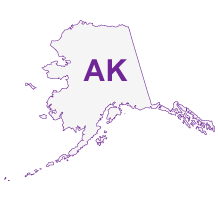
If you own a pet in Alaska, you may want to consider getting pet health insurance.
Reasons to consider Pet Insurance in Alaska
Alaska is home of the famous Iditarod, nicknamed “The Last Great Race on Earth”. The Iditarod is an annual race that takes place in early March from Anchorage to Nome. Mushers and their team of sixteen dogs, usually Huskies, travel over 1,000 miles in snowy, and sometimes blizzard, weather. According to the American Journal of Respiratory and Critical Care Medicine, 81% of dogs finish the Iditarod with lung damage. In 2015, 78 mushers participated in the Iditarod, which means over 1,200 dogs raced in dangerous terrain. Even if your pet is not one of the northern breeds eligible for this famous Alaskan race, Alaska’s harsh winters and large wildlife can cause illnesses and injuries to any type of dog.
Guidelines for Living in Alaska with Your Pet
Alaska is one of the coldest states in the US, with winter daytime temperatures averaging 5 to 30˚F. Help protect your pet from the cold by following these simple guidelines:
- Winter Checkup Make sure to take your pet to the veterinarian before the winter season starts, especially if your pet is currently suffering from any conditions. Cold weather might worsen your pet’s conditions and therefore additional treatment or procedures may be necessary to keep your four-legged family member healthy and protected.
- Know Their Limits Just like humans, most pets dislike the cold weather. Many factors can play into your pet’s cold weather tolerance such as breed, thickness of coat, how much body fat they have, and activity level. Pets that have a shorter coat and/or are short-legged will feel the cold faster since they have less protection from the elements. Pets with long hair and thick coats tend to be more cold tolerant.
- Cold-Related Illnesses There are many problems associated with freezing temperatures; however, the most common among pets are frostbite and hypothermia. You can prevent either of these conditions by bringing your pet indoors when the temperature drops. As a rule, if you are cold, your pet is cold too, even if it has long hair. If your pet is outside in the cold weather, provide your pet with an ample amount of hay (and change it regularly) rather than blankets.
- Check Their Paws Checking paws during the winter months for cold weather injury can help keep your pet healthy. If your pet has cracked or bleeding pads, take him/her to a veterinarian.
- Dangers in Alaska’s terrain extend past wintry blizzards The potential for threats exists in the summer, too! Many Alaskan plants are proven to be toxic to animals. For example, kidney failure in cats can be caused by Lilies or in any animal by Rhubarb leaves. Monkshood paralyzes nerves, lowers body temperature, and causes hypotension, and Foxglove, perhaps the deadliest, can cause cardiac arrest in animals.
Pet Insurance Plans in Alaska
For more information about pet insurance plans available in Alaska, visit PetPremium.com. Here you can find topics about your pet health in our Pet Health Center or read tips about how to purchase pet insurance.